Different Types and Purposes of Organizations
VerifiedAdded on 2023/03/16
|21
|1228
|64
PowerPoint Presentation
AI Summary
This presentation provides an overview of the different types and purposes of organizations in the business environment. It discusses the scope and size of various types of organizations, including public sector, voluntary, and private sector organizations. Examples of well-known organizations are also provided.
Contribute Materials
Your contribution can guide someone’s learning journey. Share your
documents today.
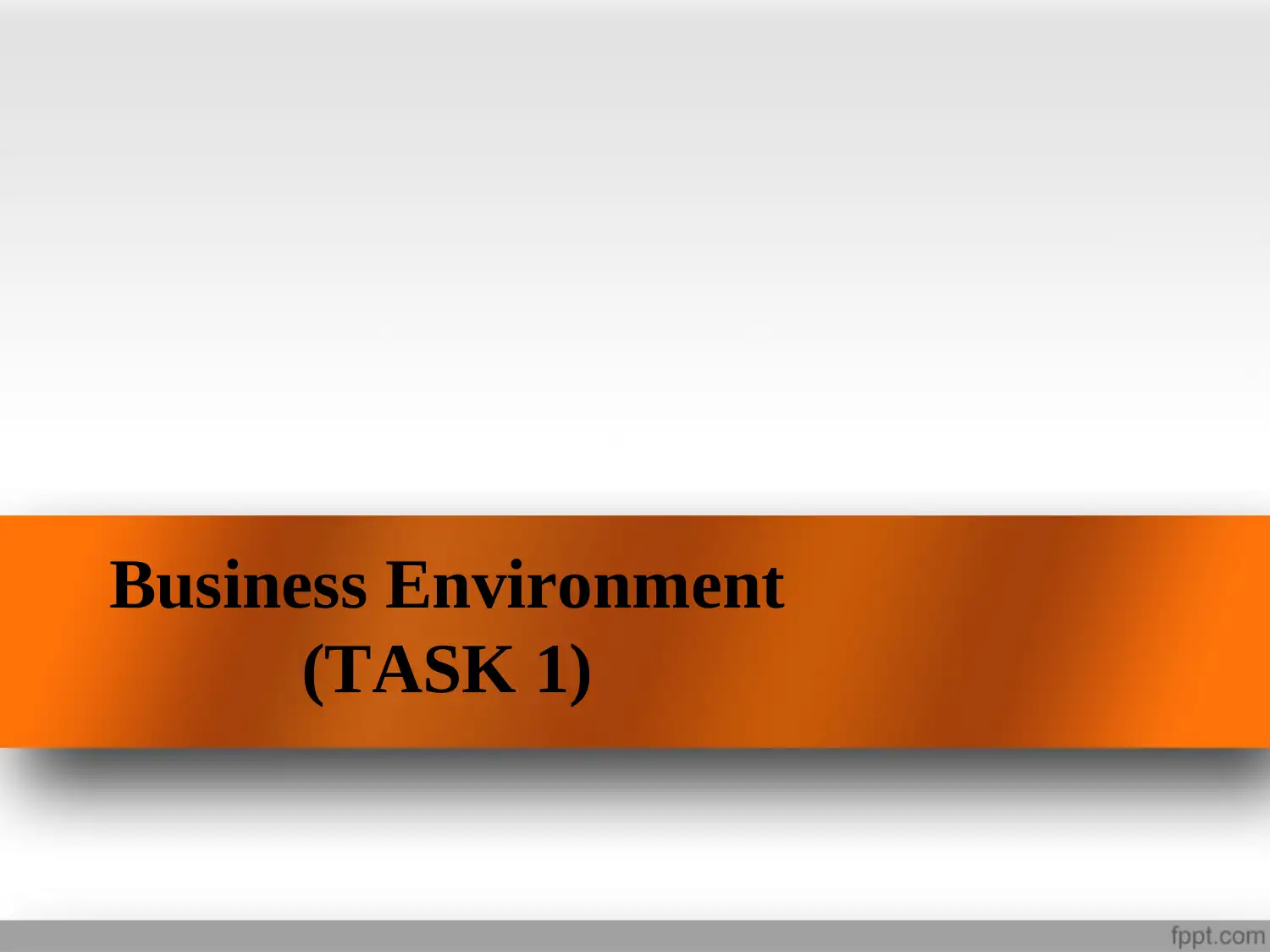
Business Environment
(TASK 1)
(TASK 1)
Secure Best Marks with AI Grader
Need help grading? Try our AI Grader for instant feedback on your assignments.
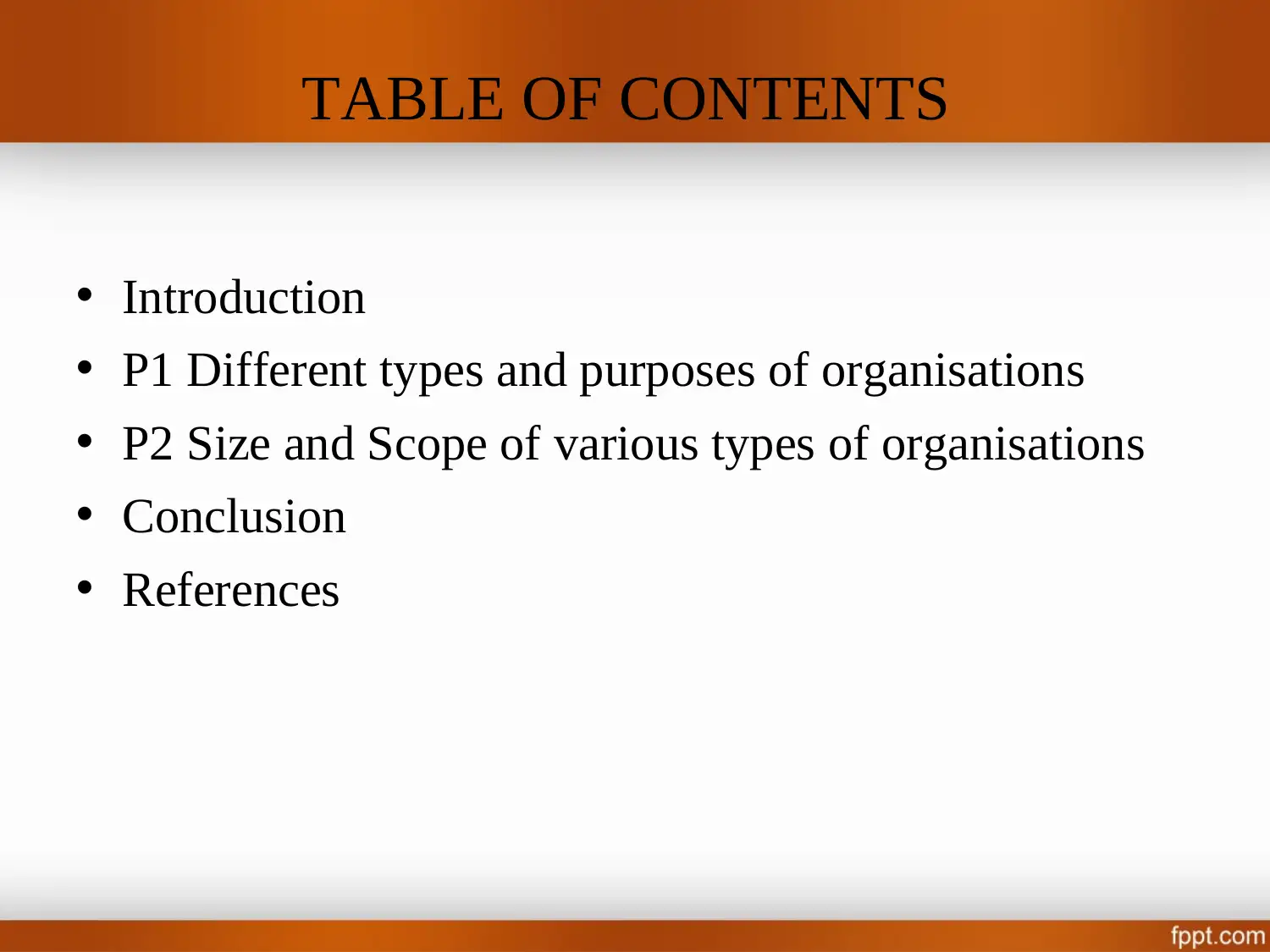
TABLE OF CONTENTS
• Introduction
• P1 Different types and purposes of organisations
• P2 Size and Scope of various types of organisations
• Conclusion
• References
• Introduction
• P1 Different types and purposes of organisations
• P2 Size and Scope of various types of organisations
• Conclusion
• References
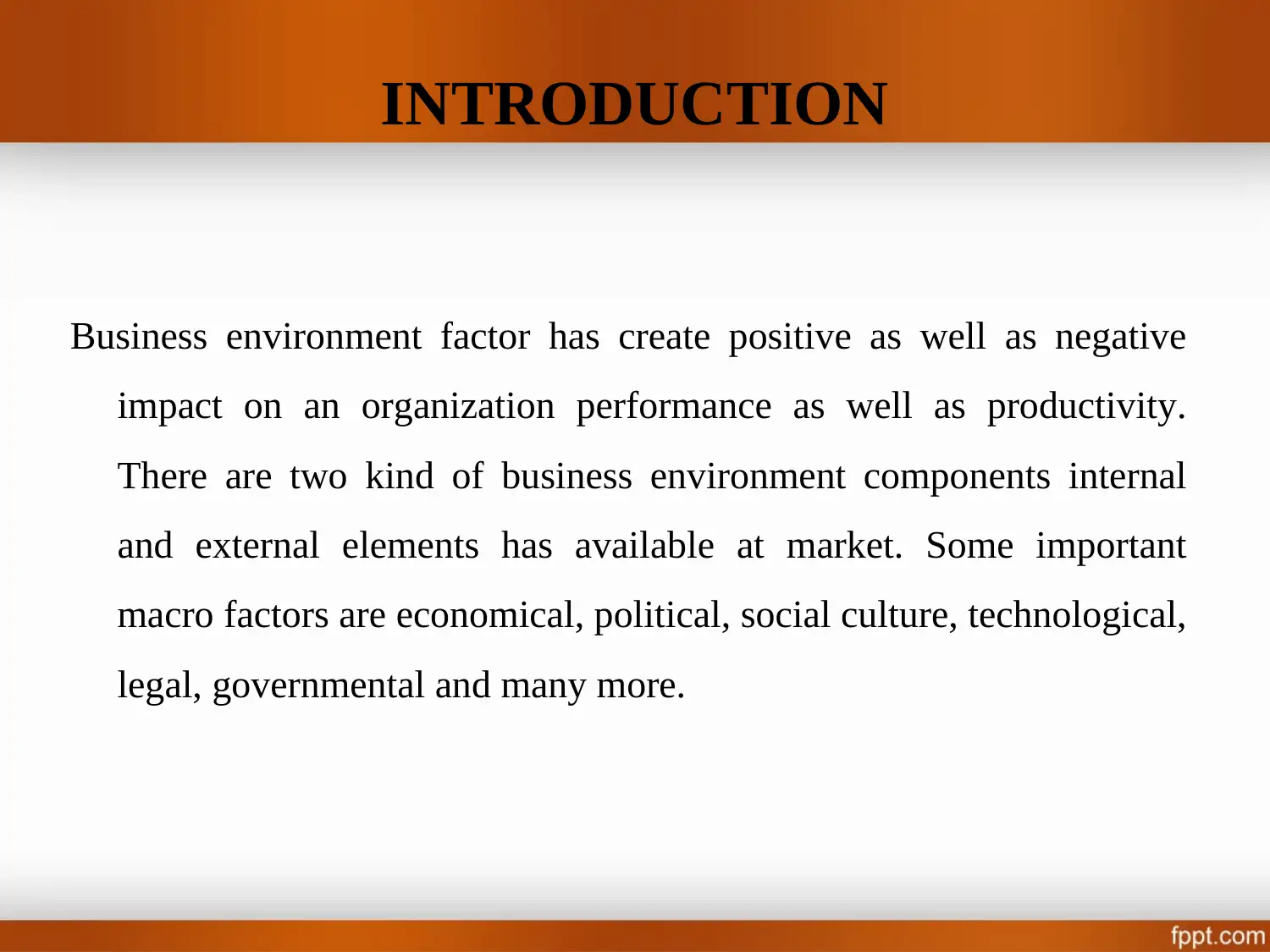
INTRODUCTION
Business environment factor has create positive as well as negative
impact on an organization performance as well as productivity.
There are two kind of business environment components internal
and external elements has available at market. Some important
macro factors are economical, political, social culture, technological,
legal, governmental and many more.
Business environment factor has create positive as well as negative
impact on an organization performance as well as productivity.
There are two kind of business environment components internal
and external elements has available at market. Some important
macro factors are economical, political, social culture, technological,
legal, governmental and many more.
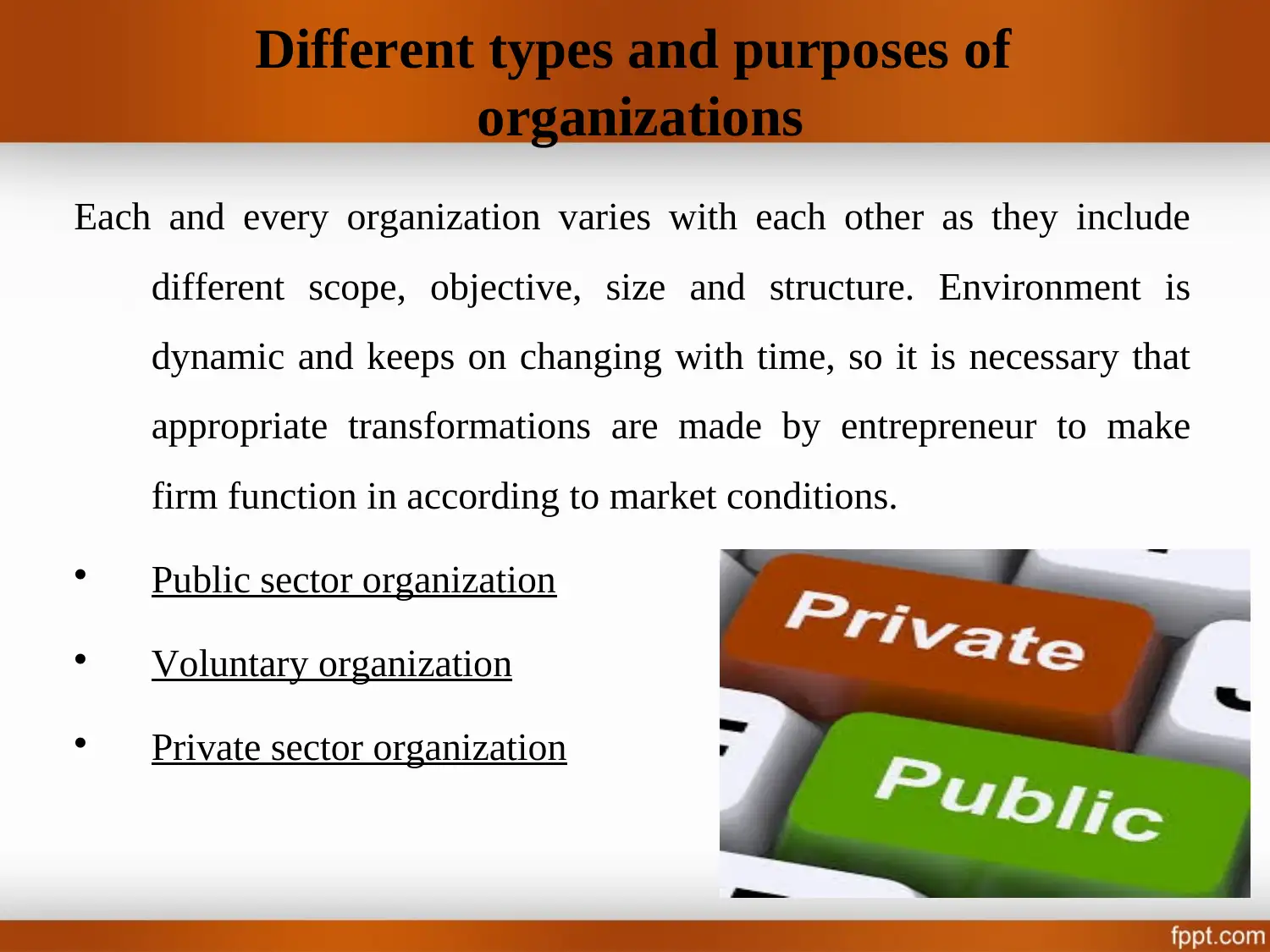
Different types and purposes of
organizations
Each and every organization varies with each other as they include
different scope, objective, size and structure. Environment is
dynamic and keeps on changing with time, so it is necessary that
appropriate transformations are made by entrepreneur to make
firm function in according to market conditions.
Public sector organization
Voluntary organization
Private sector organization
organizations
Each and every organization varies with each other as they include
different scope, objective, size and structure. Environment is
dynamic and keeps on changing with time, so it is necessary that
appropriate transformations are made by entrepreneur to make
firm function in according to market conditions.
Public sector organization
Voluntary organization
Private sector organization
Secure Best Marks with AI Grader
Need help grading? Try our AI Grader for instant feedback on your assignments.
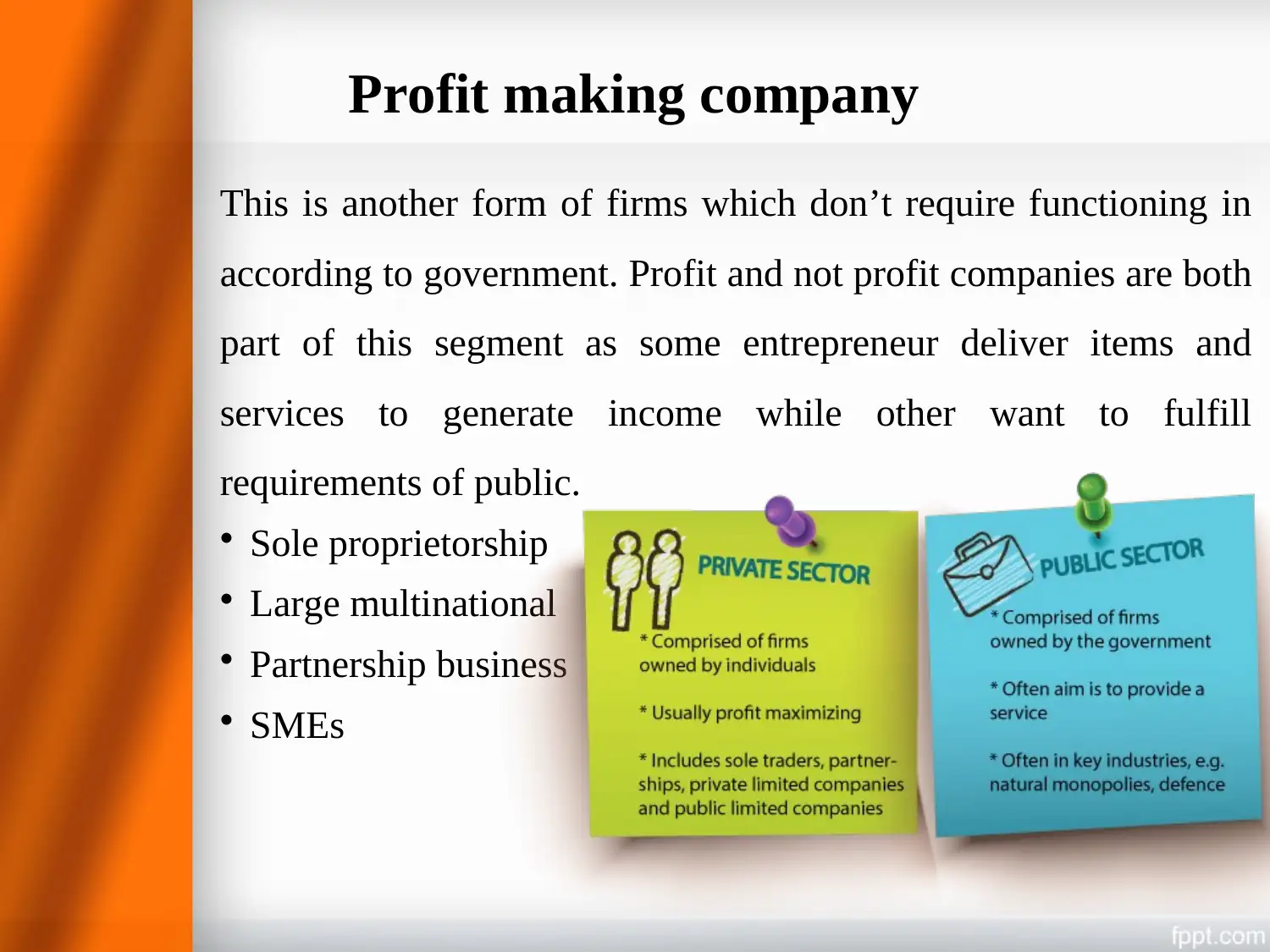
Profit making company
This is another form of firms which don’t require functioning in
according to government. Profit and not profit companies are both
part of this segment as some entrepreneur deliver items and
services to generate income while other want to fulfill
requirements of public.
Sole proprietorship
Large multinational
Partnership business
SMEs
This is another form of firms which don’t require functioning in
according to government. Profit and not profit companies are both
part of this segment as some entrepreneur deliver items and
services to generate income while other want to fulfill
requirements of public.
Sole proprietorship
Large multinational
Partnership business
SMEs
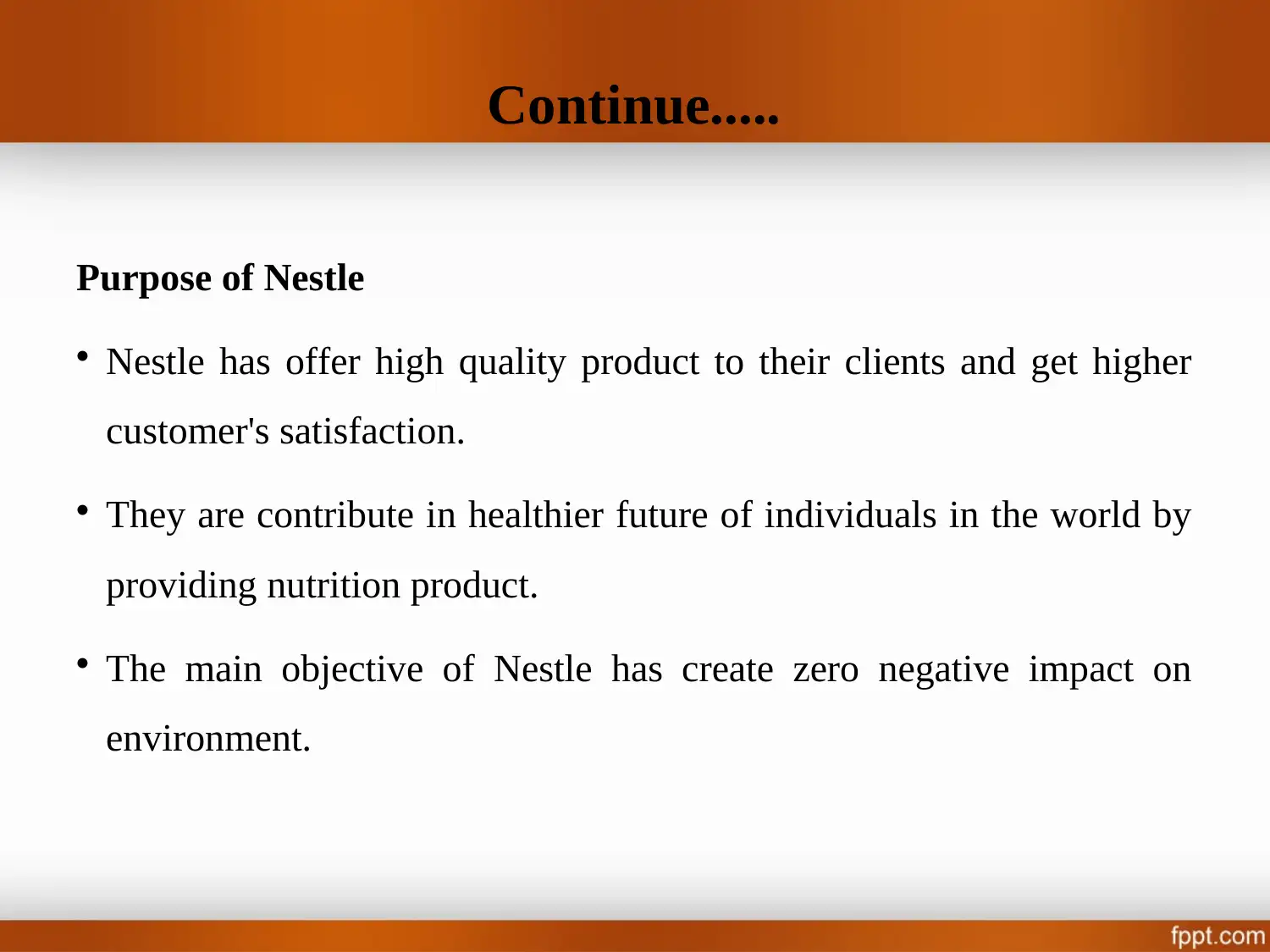
Continue.....
Purpose of Nestle
Nestle has offer high quality product to their clients and get higher
customer's satisfaction.
They are contribute in healthier future of individuals in the world by
providing nutrition product.
The main objective of Nestle has create zero negative impact on
environment.
Purpose of Nestle
Nestle has offer high quality product to their clients and get higher
customer's satisfaction.
They are contribute in healthier future of individuals in the world by
providing nutrition product.
The main objective of Nestle has create zero negative impact on
environment.
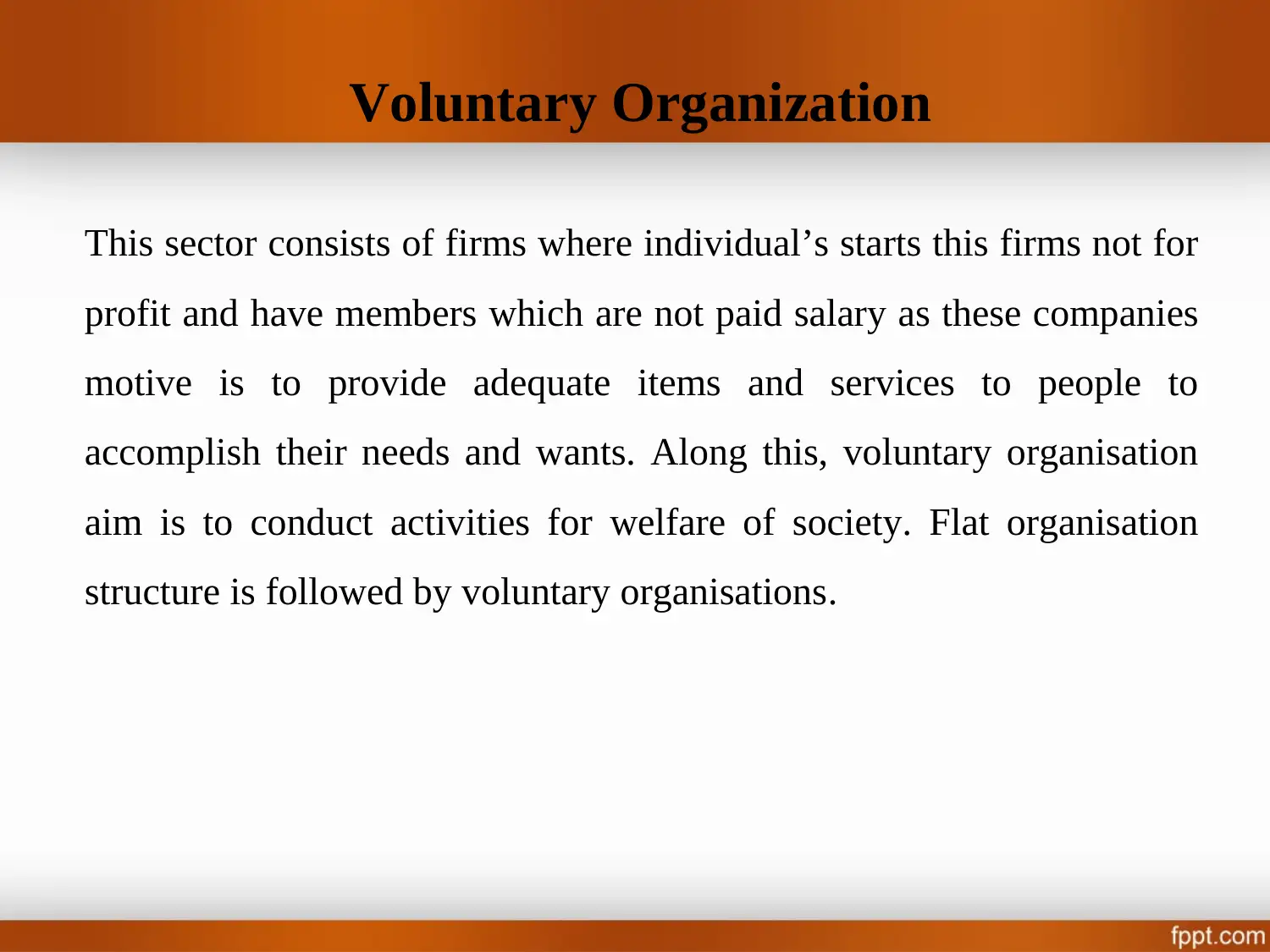
Voluntary Organization
This sector consists of firms where individual’s starts this firms not for
profit and have members which are not paid salary as these companies
motive is to provide adequate items and services to people to
accomplish their needs and wants. Along this, voluntary organisation
aim is to conduct activities for welfare of society. Flat organisation
structure is followed by voluntary organisations.
This sector consists of firms where individual’s starts this firms not for
profit and have members which are not paid salary as these companies
motive is to provide adequate items and services to people to
accomplish their needs and wants. Along this, voluntary organisation
aim is to conduct activities for welfare of society. Flat organisation
structure is followed by voluntary organisations.
Paraphrase This Document
Need a fresh take? Get an instant paraphrase of this document with our AI Paraphraser
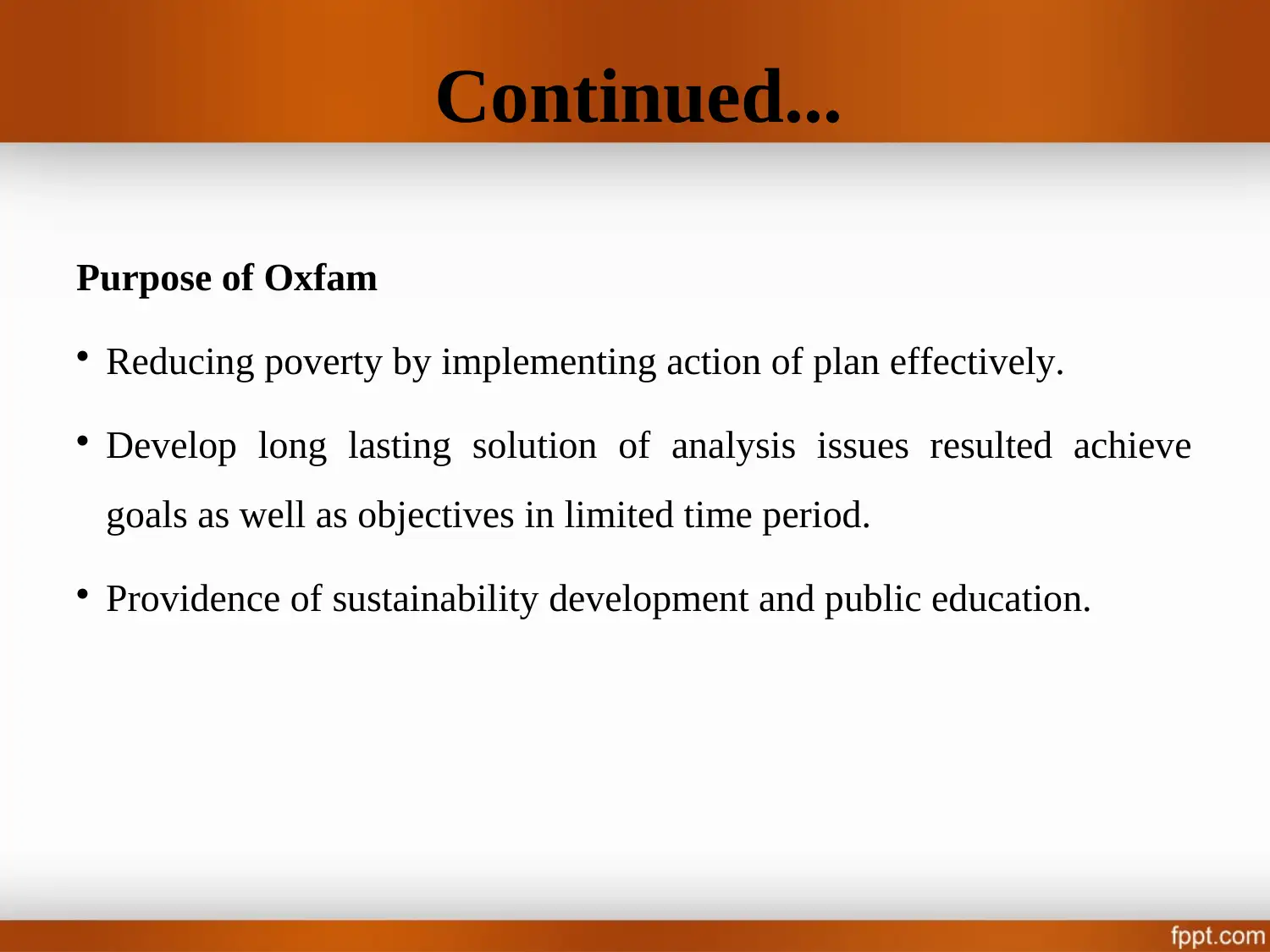
Continued...
Purpose of Oxfam
Reducing poverty by implementing action of plan effectively.
Develop long lasting solution of analysis issues resulted achieve
goals as well as objectives in limited time period.
Providence of sustainability development and public education.
Purpose of Oxfam
Reducing poverty by implementing action of plan effectively.
Develop long lasting solution of analysis issues resulted achieve
goals as well as objectives in limited time period.
Providence of sustainability development and public education.
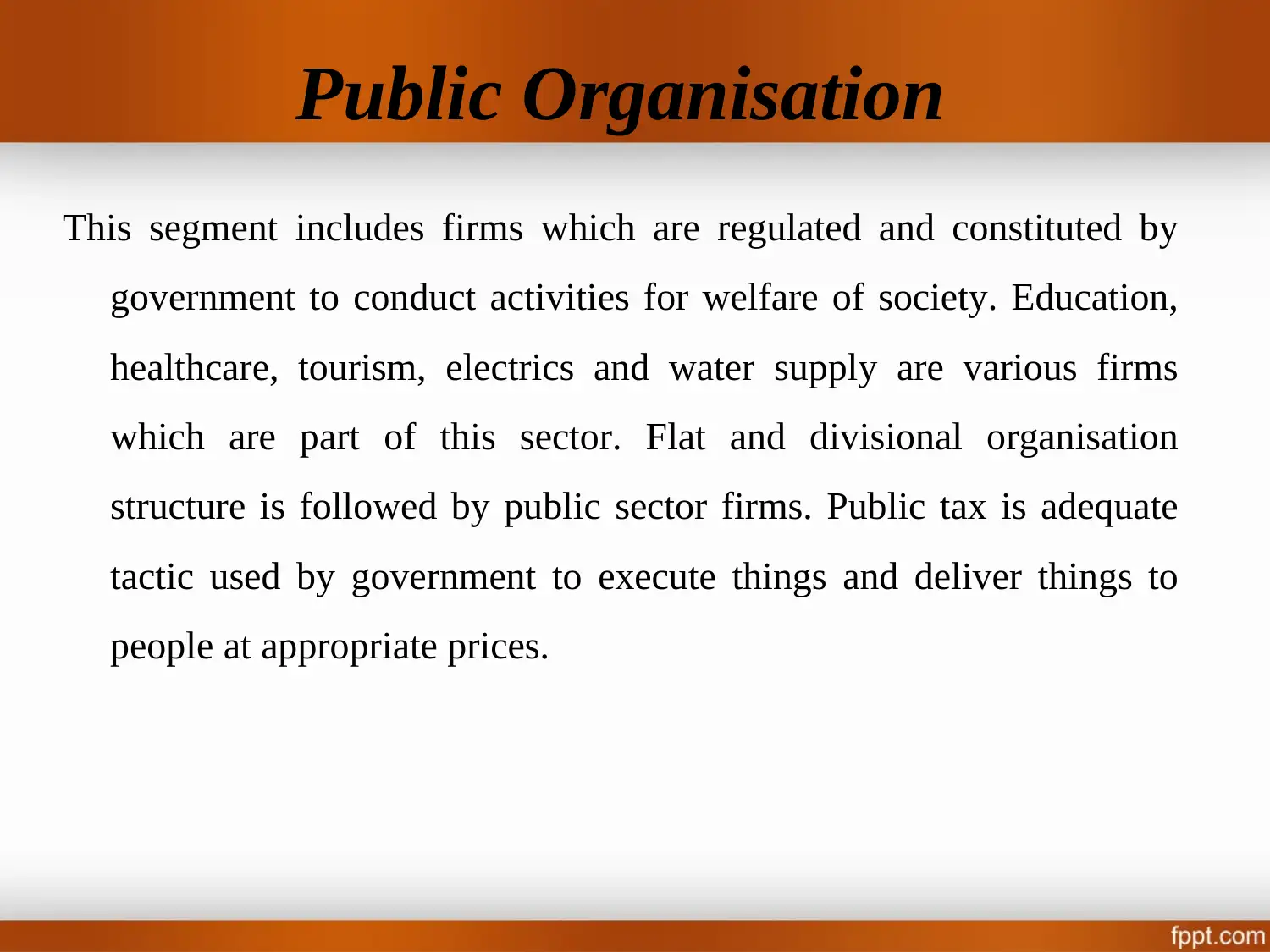
Public Organisation
This segment includes firms which are regulated and constituted by
government to conduct activities for welfare of society. Education,
healthcare, tourism, electrics and water supply are various firms
which are part of this sector. Flat and divisional organisation
structure is followed by public sector firms. Public tax is adequate
tactic used by government to execute things and deliver things to
people at appropriate prices.
This segment includes firms which are regulated and constituted by
government to conduct activities for welfare of society. Education,
healthcare, tourism, electrics and water supply are various firms
which are part of this sector. Flat and divisional organisation
structure is followed by public sector firms. Public tax is adequate
tactic used by government to execute things and deliver things to
people at appropriate prices.
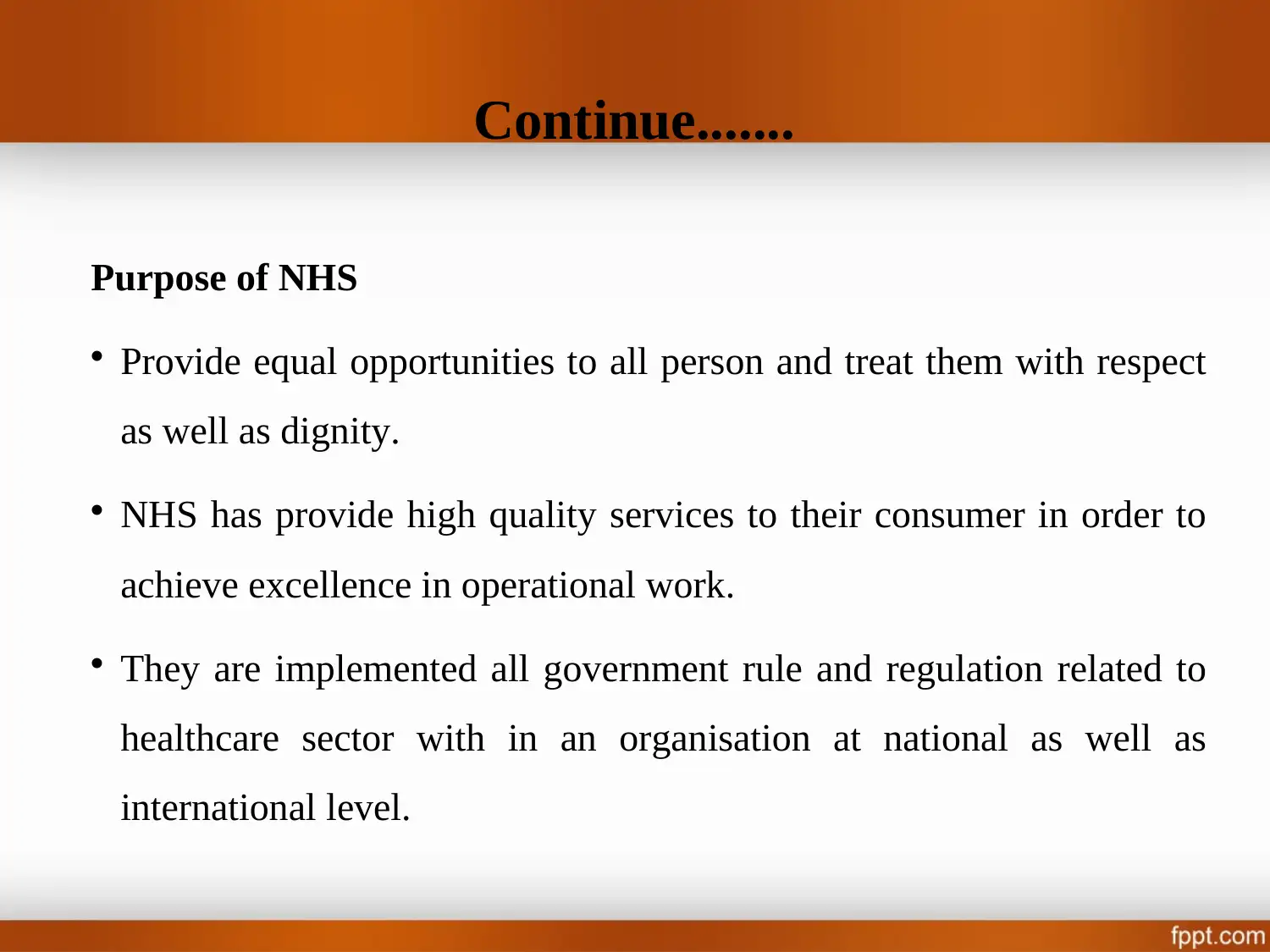
Continue.......
Purpose of NHS
Provide equal opportunities to all person and treat them with respect
as well as dignity.
NHS has provide high quality services to their consumer in order to
achieve excellence in operational work.
They are implemented all government rule and regulation related to
healthcare sector with in an organisation at national as well as
international level.
Purpose of NHS
Provide equal opportunities to all person and treat them with respect
as well as dignity.
NHS has provide high quality services to their consumer in order to
achieve excellence in operational work.
They are implemented all government rule and regulation related to
healthcare sector with in an organisation at national as well as
international level.
Secure Best Marks with AI Grader
Need help grading? Try our AI Grader for instant feedback on your assignments.

Continue.....
Legal structure of NHS
Central government: Over see all section of authorities in order to
operating business activities effectively.
State government: Provide contribution in state in order to
completing their all function appropriately.
Local government: All function are done related to administration
of NHS organisation with in work place.
Legal structure of NHS
Central government: Over see all section of authorities in order to
operating business activities effectively.
State government: Provide contribution in state in order to
completing their all function appropriately.
Local government: All function are done related to administration
of NHS organisation with in work place.

Size and Scope of various types of
organizations
Scope is concept which defines information about goal and objectives
which entrepreneur requires achieving. These are taken as
benchmarks used by heads to design system and execute business
operations in adequate manner.
Micro, small and medium-sized enterprises
Limited Companies
NGO
organizations
Scope is concept which defines information about goal and objectives
which entrepreneur requires achieving. These are taken as
benchmarks used by heads to design system and execute business
operations in adequate manner.
Micro, small and medium-sized enterprises
Limited Companies
NGO
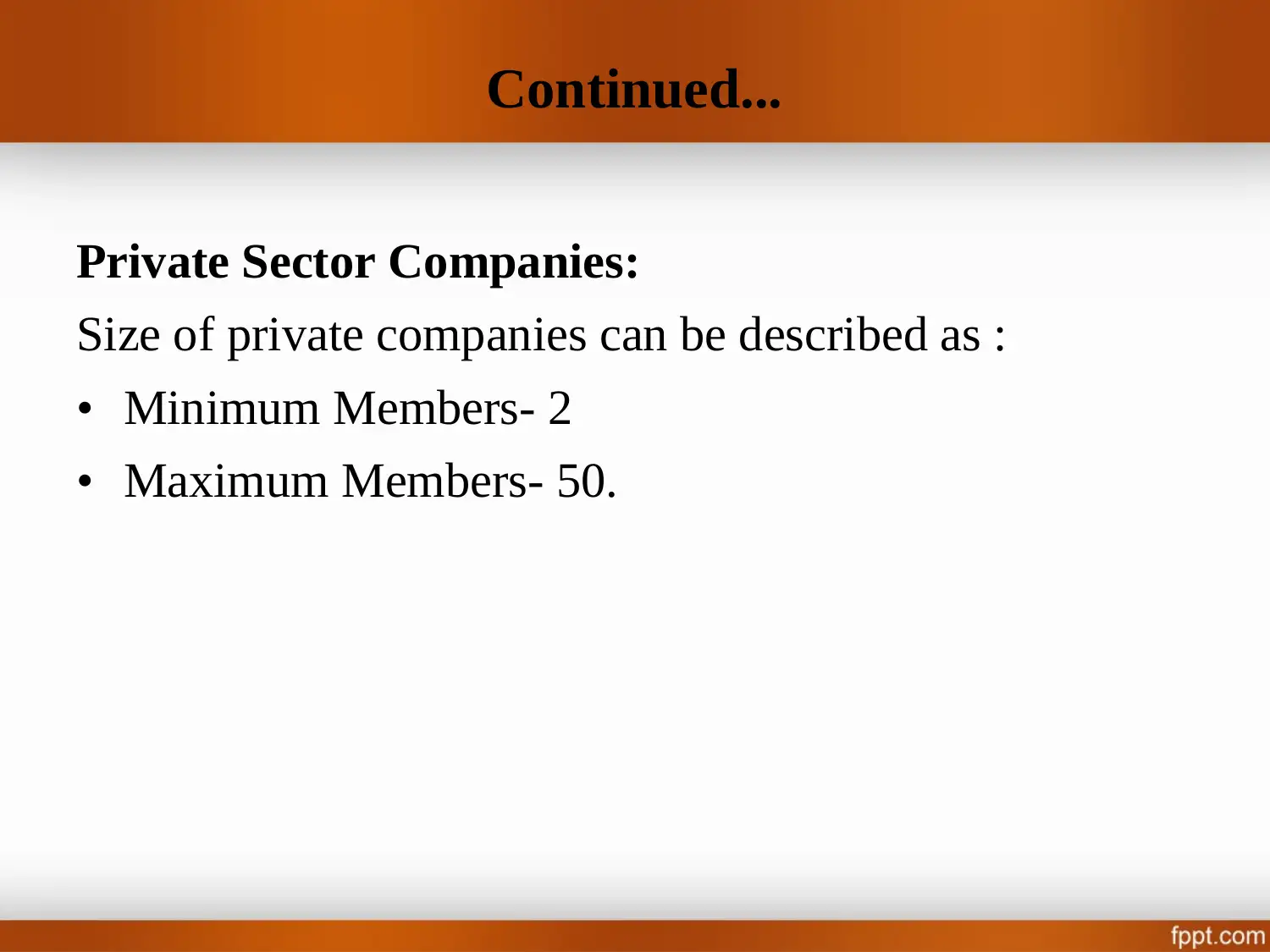
Continued...
Private Sector Companies:
Size of private companies can be described as :
• Minimum Members- 2
• Maximum Members- 50.
Private Sector Companies:
Size of private companies can be described as :
• Minimum Members- 2
• Maximum Members- 50.
Paraphrase This Document
Need a fresh take? Get an instant paraphrase of this document with our AI Paraphraser
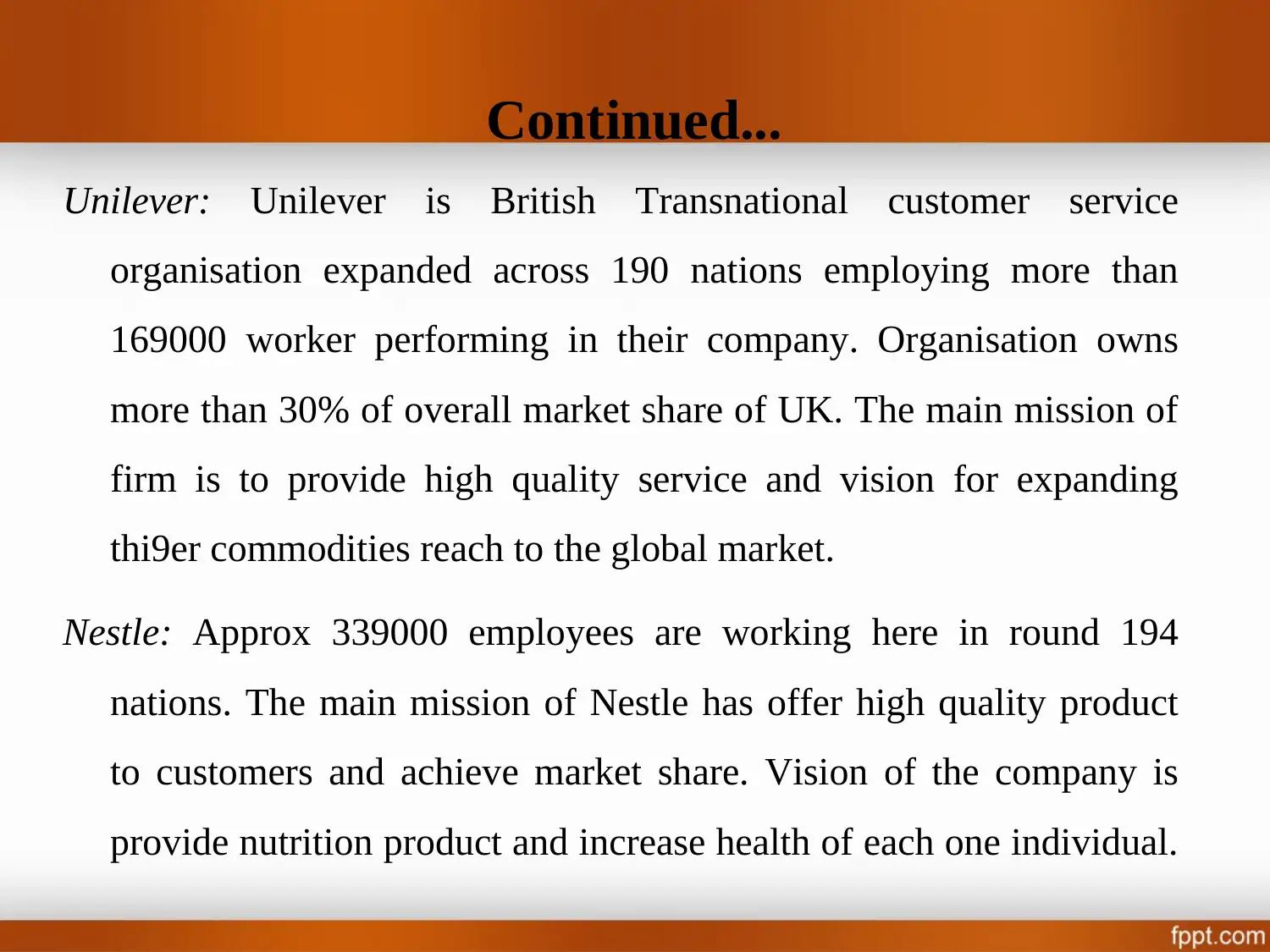
Continued...
Unilever: Unilever is British Transnational customer service
organisation expanded across 190 nations employing more than
169000 worker performing in their company. Organisation owns
more than 30% of overall market share of UK. The main mission of
firm is to provide high quality service and vision for expanding
thi9er commodities reach to the global market.
Nestle: Approx 339000 employees are working here in round 194
nations. The main mission of Nestle has offer high quality product
to customers and achieve market share. Vision of the company is
provide nutrition product and increase health of each one individual.
Unilever: Unilever is British Transnational customer service
organisation expanded across 190 nations employing more than
169000 worker performing in their company. Organisation owns
more than 30% of overall market share of UK. The main mission of
firm is to provide high quality service and vision for expanding
thi9er commodities reach to the global market.
Nestle: Approx 339000 employees are working here in round 194
nations. The main mission of Nestle has offer high quality product
to customers and achieve market share. Vision of the company is
provide nutrition product and increase health of each one individual.
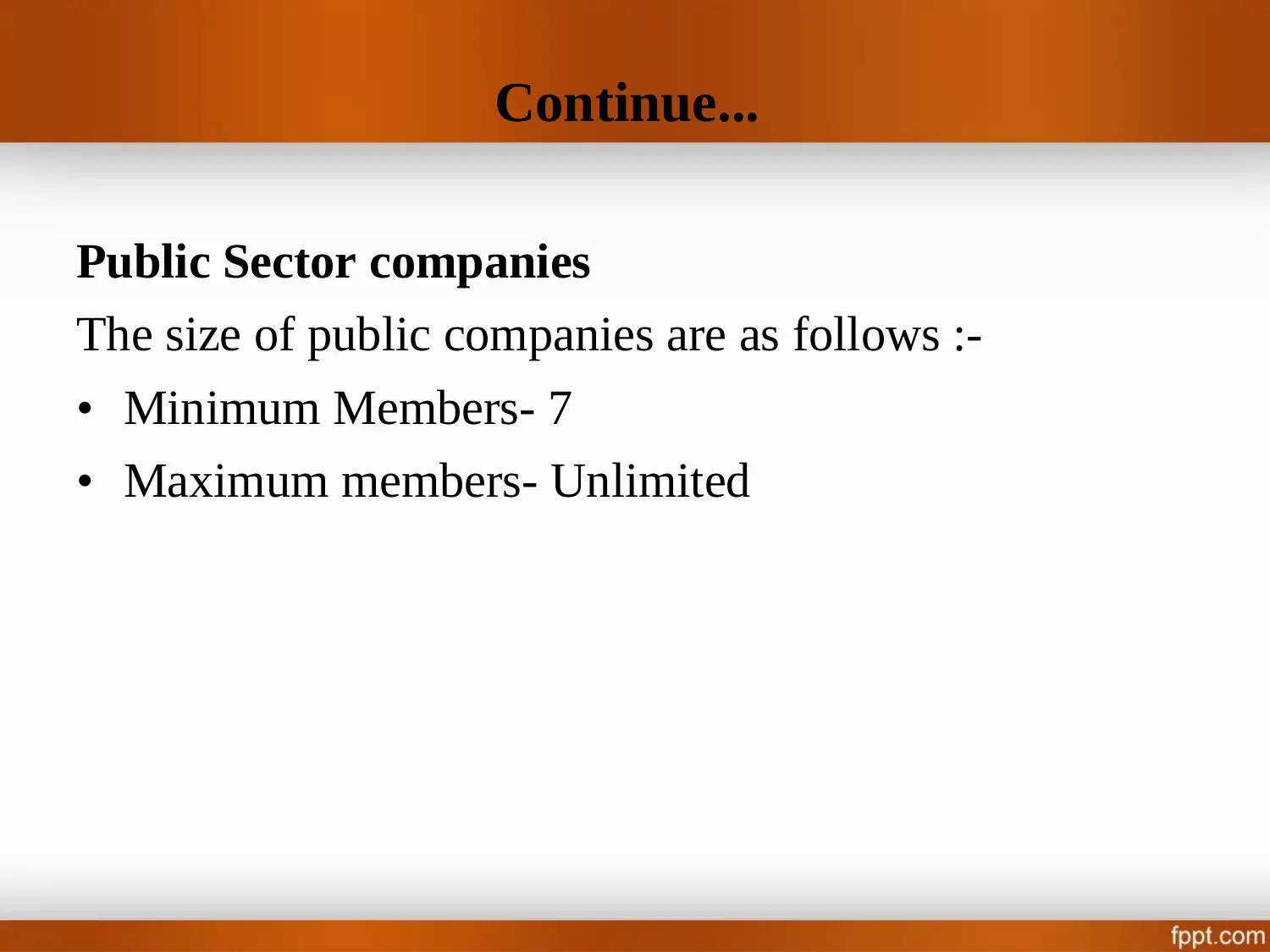
Continue...
Public Sector companies
The size of public companies are as follows :-
• Minimum Members- 7
• Maximum members- Unlimited
Public Sector companies
The size of public companies are as follows :-
• Minimum Members- 7
• Maximum members- Unlimited
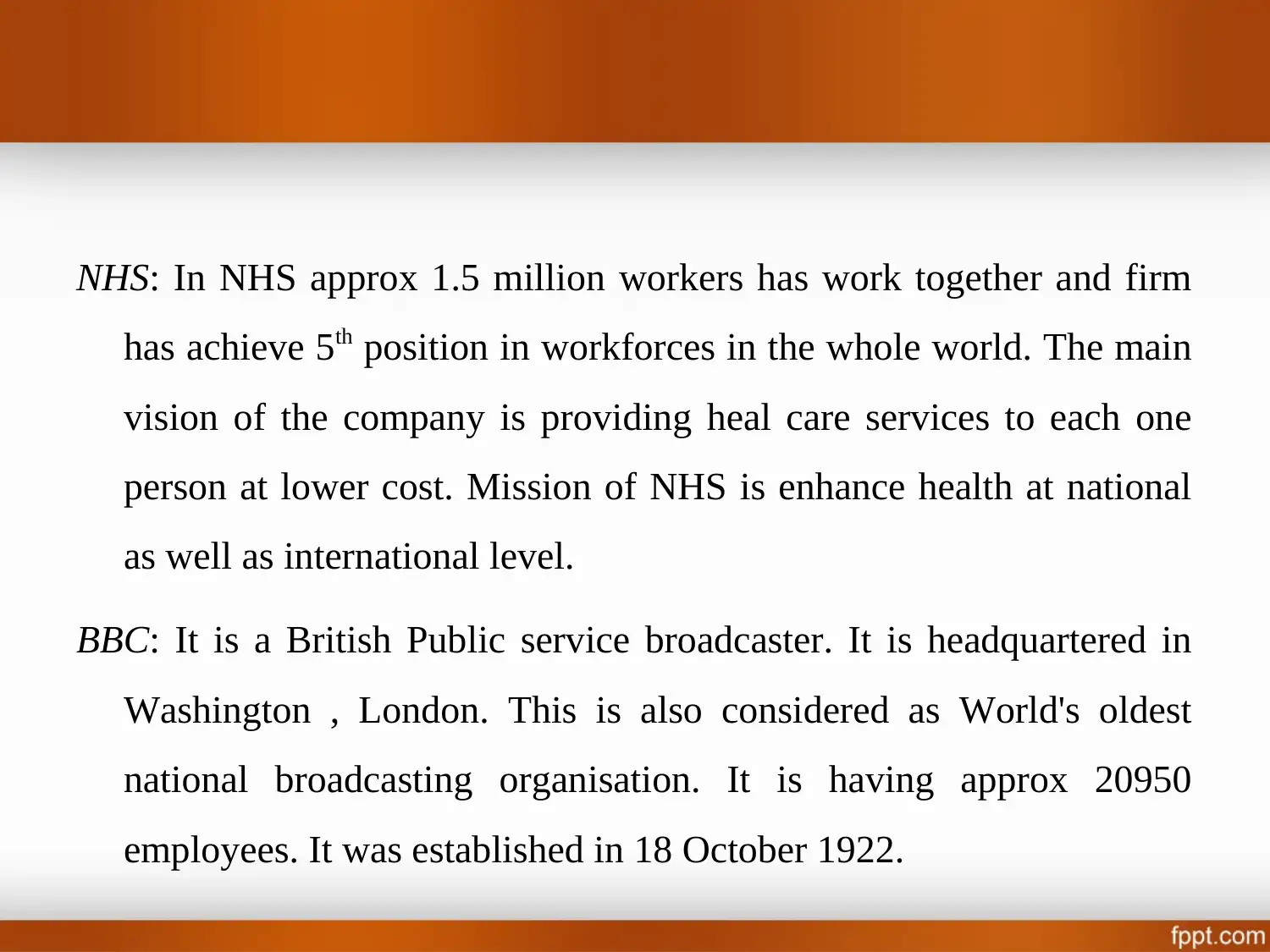
NHS: In NHS approx 1.5 million workers has work together and firm
has achieve 5th position in workforces in the whole world. The main
vision of the company is providing heal care services to each one
person at lower cost. Mission of NHS is enhance health at national
as well as international level.
BBC: It is a British Public service broadcaster. It is headquartered in
Washington , London. This is also considered as World's oldest
national broadcasting organisation. It is having approx 20950
employees. It was established in 18 October 1922.
has achieve 5th position in workforces in the whole world. The main
vision of the company is providing heal care services to each one
person at lower cost. Mission of NHS is enhance health at national
as well as international level.
BBC: It is a British Public service broadcaster. It is headquartered in
Washington , London. This is also considered as World's oldest
national broadcasting organisation. It is having approx 20950
employees. It was established in 18 October 1922.
Secure Best Marks with AI Grader
Need help grading? Try our AI Grader for instant feedback on your assignments.
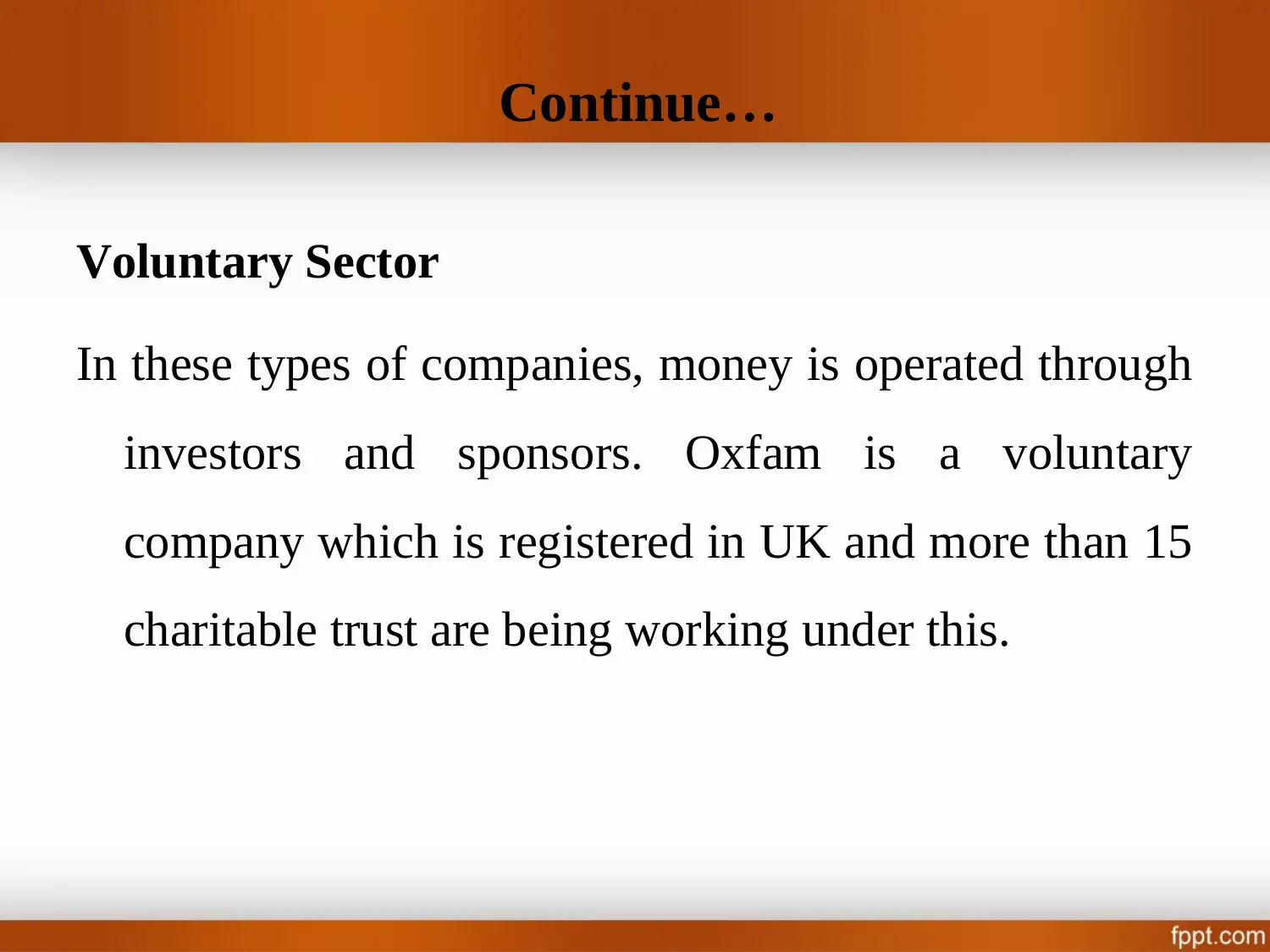
Continue…
Voluntary Sector
In these types of companies, money is operated through
investors and sponsors. Oxfam is a voluntary
company which is registered in UK and more than 15
charitable trust are being working under this.
Voluntary Sector
In these types of companies, money is operated through
investors and sponsors. Oxfam is a voluntary
company which is registered in UK and more than 15
charitable trust are being working under this.
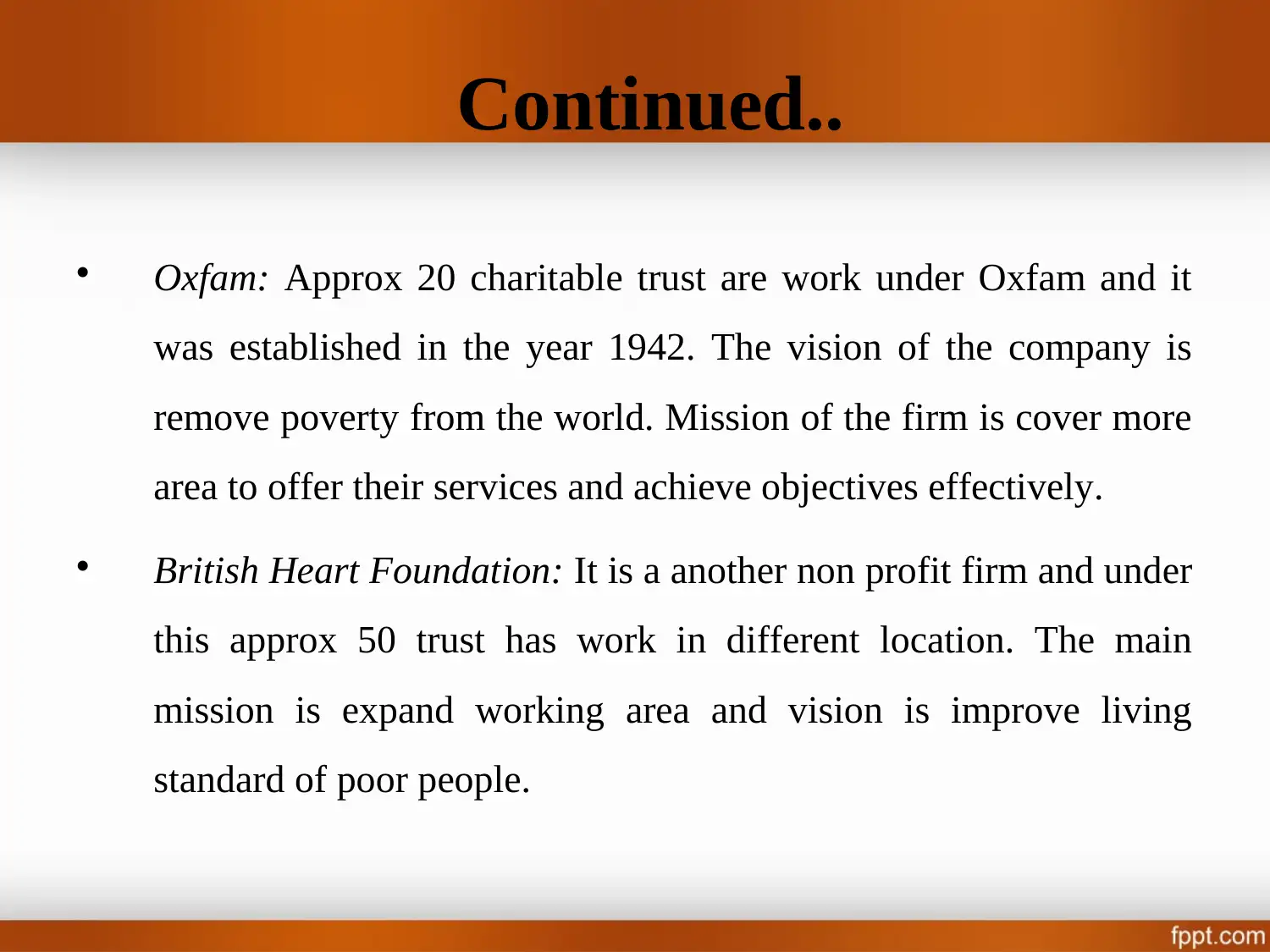
Continued..
Oxfam: Approx 20 charitable trust are work under Oxfam and it
was established in the year 1942. The vision of the company is
remove poverty from the world. Mission of the firm is cover more
area to offer their services and achieve objectives effectively.
British Heart Foundation: It is a another non profit firm and under
this approx 50 trust has work in different location. The main
mission is expand working area and vision is improve living
standard of poor people.
Oxfam: Approx 20 charitable trust are work under Oxfam and it
was established in the year 1942. The vision of the company is
remove poverty from the world. Mission of the firm is cover more
area to offer their services and achieve objectives effectively.
British Heart Foundation: It is a another non profit firm and under
this approx 50 trust has work in different location. The main
mission is expand working area and vision is improve living
standard of poor people.
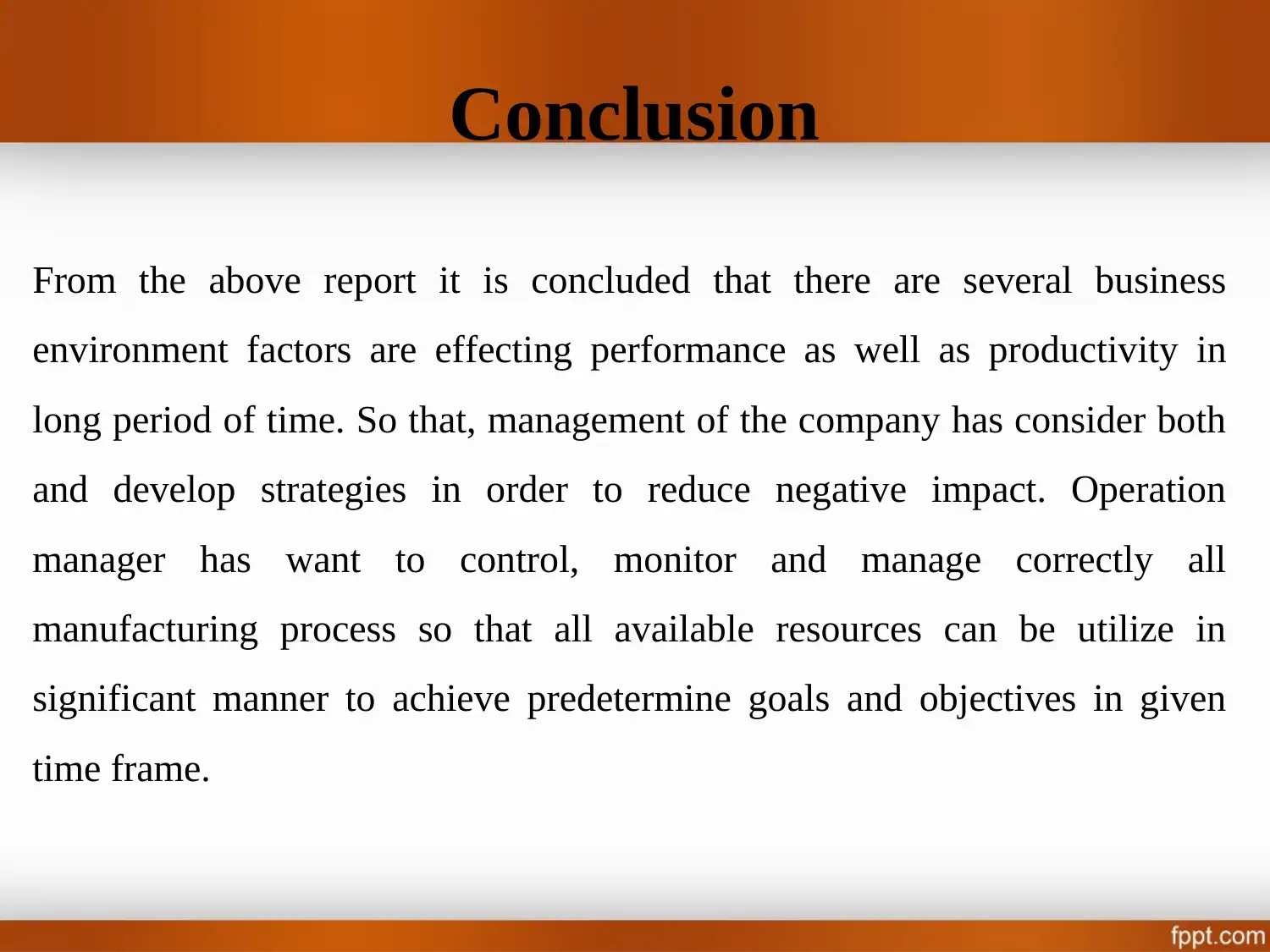
Conclusion
From the above report it is concluded that there are several business
environment factors are effecting performance as well as productivity in
long period of time. So that, management of the company has consider both
and develop strategies in order to reduce negative impact. Operation
manager has want to control, monitor and manage correctly all
manufacturing process so that all available resources can be utilize in
significant manner to achieve predetermine goals and objectives in given
time frame.
From the above report it is concluded that there are several business
environment factors are effecting performance as well as productivity in
long period of time. So that, management of the company has consider both
and develop strategies in order to reduce negative impact. Operation
manager has want to control, monitor and manage correctly all
manufacturing process so that all available resources can be utilize in
significant manner to achieve predetermine goals and objectives in given
time frame.
Paraphrase This Document
Need a fresh take? Get an instant paraphrase of this document with our AI Paraphraser
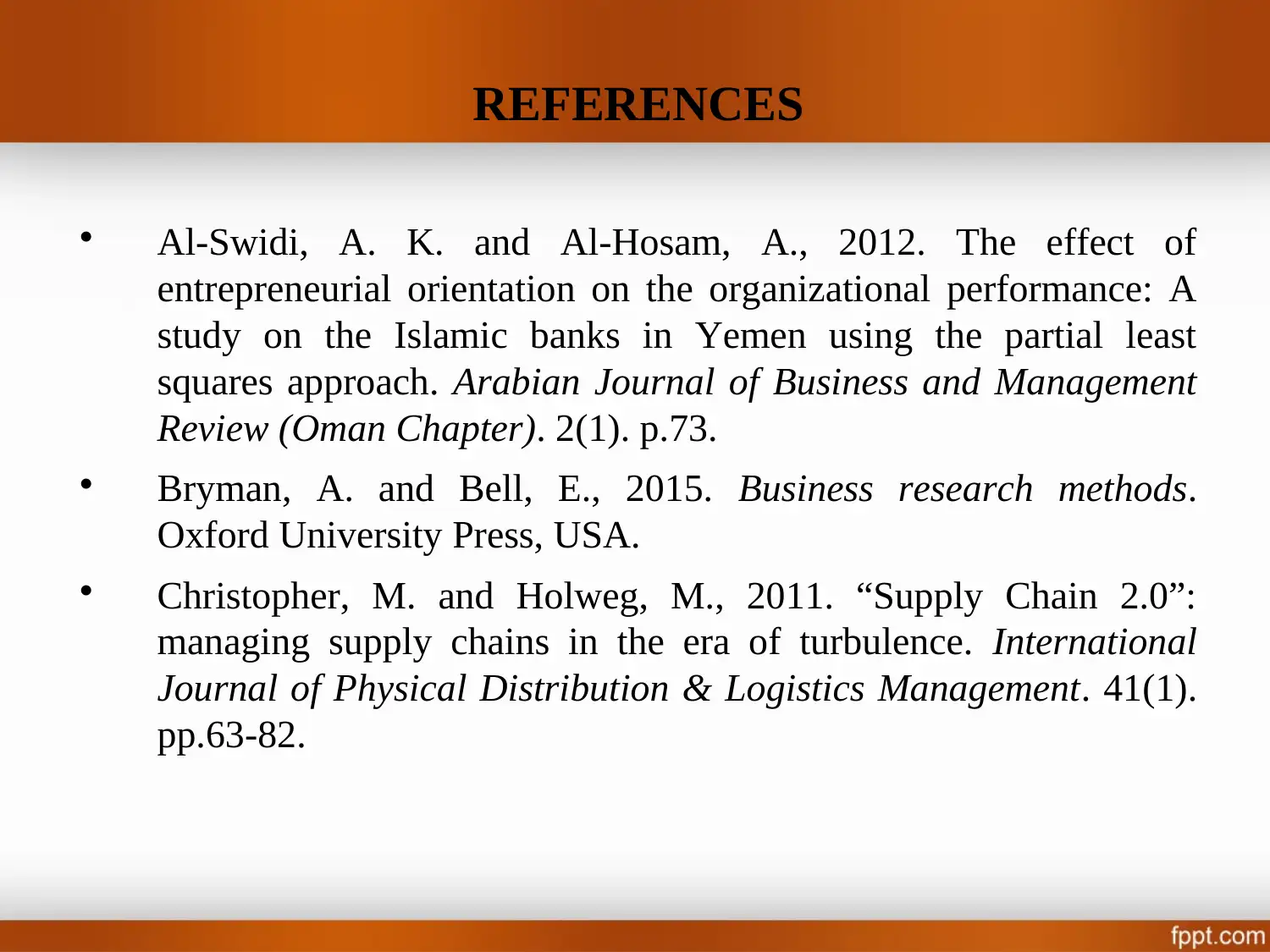
REFERENCES
Al-Swidi, A. K. and Al-Hosam, A., 2012. The effect of
entrepreneurial orientation on the organizational performance: A
study on the Islamic banks in Yemen using the partial least
squares approach. Arabian Journal of Business and Management
Review (Oman Chapter). 2(1). p.73.
Bryman, A. and Bell, E., 2015. Business research methods.
Oxford University Press, USA.
Christopher, M. and Holweg, M., 2011. “Supply Chain 2.0”:
managing supply chains in the era of turbulence. International
Journal of Physical Distribution & Logistics Management. 41(1).
pp.63-82.
Al-Swidi, A. K. and Al-Hosam, A., 2012. The effect of
entrepreneurial orientation on the organizational performance: A
study on the Islamic banks in Yemen using the partial least
squares approach. Arabian Journal of Business and Management
Review (Oman Chapter). 2(1). p.73.
Bryman, A. and Bell, E., 2015. Business research methods.
Oxford University Press, USA.
Christopher, M. and Holweg, M., 2011. “Supply Chain 2.0”:
managing supply chains in the era of turbulence. International
Journal of Physical Distribution & Logistics Management. 41(1).
pp.63-82.

Thank You
1 out of 21
Related Documents
Your All-in-One AI-Powered Toolkit for Academic Success.
+13062052269
info@desklib.com
Available 24*7 on WhatsApp / Email
![[object Object]](/_next/static/media/star-bottom.7253800d.svg)
Unlock your academic potential
© 2024 | Zucol Services PVT LTD | All rights reserved.





